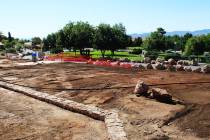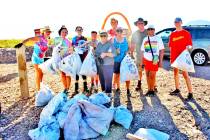Book takes look at Lake Mead
From the time she was growing up in El Cajon, Calif., Erin Eichenberg has been fascinated with archaeology.
She credits her aunt with piquing her interest in the outdoors at a young age, and she carried her penchant for petroglyphs and archaeology to UNLV, where she received a degree in anthropology. Now, as a 33-year-old museum specialist for the National Park Service, Eichenberg published a picture-friendly, historical book titled “Lake Mead.”
The book, published by Arcadia Publishing and The History Press, takes readers through a visual history of Lake Mead National Recreation Area.
Eichenberg, who began working for the Park Service as an archaeological technician in 2007, was contacted by staff at the Boulder City-Hoover Dam Museum to see if she would be interested in writing a book about Lake Mead.
“I was excited because I thought about contacting (Arcadia) prior,” she said. “Throughout the years I’ve been scanning our historic photo collection, and I wanted to share them with people.”
Eichenberg spent six months working on the book, poring over more than 3,000 photos from the U.S. Geological Survey, the Boulder City-Hoover Dam Museum, the Park Service and the Bureau of Reclamation, which she narrowed down to a 128-page book featuring 148 black-and-white pictures.
While juggling her full-time Park Service job and digging through archives for her book, Eichenberg worked on her master’s thesis for her distant learning program in the United Kingdom.
“Once you start reading it, it kind of blows your mind,” Eichenberg said about her book. “The main challenge was trying not to replicate material from other books.”
“Lake Mead” begins with photos of prehistoric animal bones, and 13-million-year-old sedimentary rock at the Horse Spring Formation. Readers learn how the area was created after Hoover Dam was completed in 1935.
Each photo has a brief caption describing it.
“Some people don’t like to read a lot of text, so they can read the caption. … It serves the purpose for a different group of people,” she said.
While browsing the pages, readers gain a better understanding of early settlers, including the hunter-gatherers who came to Southern Nevada 11,000 years ago.
Photos of St. Thomas, the town that flooded in 1938 once Lake Mead began to fill, are included. Originally settled by Mormon pioneers in 1865, the government purchased homes in St. Thomas because after the dam was completed, flooding of the town was inevitable. Because of the recent drought, some of the town’s artifacts have re-emerged from the lake.
The book also focuses on the importance of Lake Mead in recreational postwar-America. In 1964, it was designated as the Park Service’s first recreation area, and annually maintains top-10 visitation throughout the service’s 400 units with an average of 6.5 million visitors a year.
Eichenberg wanted to share the photos that are rarely seen by the public. She said she even learned new things while compiling the book.
“I didn’t realize the expense of the planning that went into Hoover Dam, and how much extra planning came into getting the recreation area created,” she said. “A lot of other people don’t know how the recreation area came to be, and how these other things around it influenced how the park was formed.”
“Working with Erin on ‘Lake Mead’ was such a wonderful experience. Her knowledge and expertise from working at the park really shines through in the book,” said Ginny Rasmussen, title manager for Arcadia Publishing. “Through historic photographs, she has captured the history behind what has become one of America’s most popular recreation areas.”
“Lake Mead” was released Feb. 2.

















